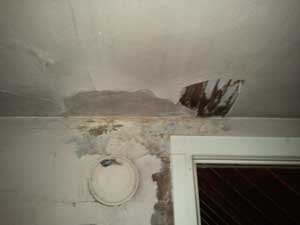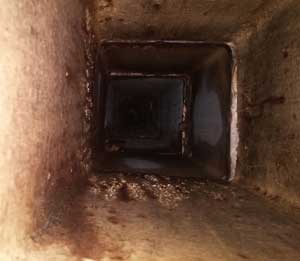Chimney Leaking From The Inside
Disclaimer:
These problems are meant to be examples of the common ways chimneys can leak from my past experiences. Any of these examples or none of these examples may apply to your chimney. Always contact a licensed chimney expert for your particular chimney leaking problems.
 Chimneys can leak from the inside out as well. When you burn a gas appliance, water is produced by the combustion process. In a properly sized vent or chimney, this water is in the form of steam. The draft of the chimney takes the steam up and out of the chimney. Not only can not enough heat cause drafting problems but nesting animals can cause no draft and can cause dangerous situations! Check out this No Rain Cap article for more info on nesting animals.
Chimneys can leak from the inside out as well. When you burn a gas appliance, water is produced by the combustion process. In a properly sized vent or chimney, this water is in the form of steam. The draft of the chimney takes the steam up and out of the chimney. Not only can not enough heat cause drafting problems but nesting animals can cause no draft and can cause dangerous situations! Check out this No Rain Cap article for more info on nesting animals.
Chimney leaking problems can arise when the chimney is NOT the right size for the appliances using it. When the chimney is too big for the appliance(s), the appliance(s) do not provide enough heat to warm the chimney flue up sufficiently. When the chimney flue is not warm enough, the steam starts to cool down as it gets higher in the chimney. When the steam cools down enough, it starts to form liquid water again. This can literally produce rain, yes rain, inside of the chimney if the chimney is cool enough. This type of problem is especially pronounced during the winter, when the exposed part of the chimney is extremely cold.
Simplified example of cross-sectional areas:

If you have a gas burning water heater that has a 3" vent collar, the cross-sectional area is about 7.09 square inches. Now if it is vented into a common 8" x 8" chimney flue tile, which on average has a 7 1/2" x 7 1/2" interior, which would be 56.26 square inches.

"Water forming in the chimney"
A water heater, typically, does not emit enough heat to heat up the entire chimney sufficiently enough to vent out the steam that it is producing along with the other gases that burning gas creates. So as the steam rises it starts to convert back into a liquid form. Many older chimneys used standard mortar between the flue tiles. The water is absorbed into the mortar joints which then starts to deteriorate them and eventually turn them to sand. The water that is still being formed can then run behind the brick of the chimney and again through the mortar and into the house.
Over time, the water that is being produced in the chimney starts to deteriorate the inside of the chimney. Eventually, if enough damage has occurred, water will start to leech through the brick and mortar of the chimney and into the house. Efflorescence is again one of the first signs that a homeowner will notice of a failed chimney flue liner.
